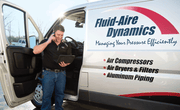Is the PSI of your compressed air system too high? As many as 80% of manufacturers are running their systems at a higher PSI than necessary for their production processes. Reducing the PSI of your plant may be your largest — and easiest — opportunity for energy savings. Best of all? Many of the things you can do to reduce your plant pressure are very inexpensive — or even free!
Use these energy-saving tips to make your compressed air system more efficient and cost-effective. You could save thousands on energy costs annually!
Saving Energy by Reducing PSI

Compressed air, as we say, is the 4th utility for manufacturers… and by far the most expensive, when you look at energy consumption for compressed air production. A typical 100 HP air compressor, if running 24/7/365, can cost up to $78,000 in energy annually. The higher the PSI your compressed air system is maintaining, the higher these energy costs will be.
For that reason, compressed air represents “low hanging fruit” when it comes to energy reduction and cost savings. Lowering PSI (while still meeting minimum pressure requirements) is one of the best and easiest ways to reduce energy consumption for compressed air and improve the overall energy efficiency for your plant. Reducing your plant pressure by even a few PSI can translate to hundreds or thousands of dollars each year in energy savings. The typical manufacturing facility can save 7-10% in energy costs annually for compressed air production by reducing plant pressure by 15 or 20 PSI.
Aire Tip: A 2 PSI reduction in plant pressure will save ~1% in energy costs for your compressed air system.
How Much PSI Do You Really Need?

Most manufacturing plants are running somewhere between 110 and 125 PSI for regular operations. For many of them, this is higher than necessary to meet production demands. In fact, we find that the average industrial compressed air system is running about 15-20% higher than necessary. This leaves ample opportunity to lower plant pressure while still meeting minimum pressure requirements for applications.
This typically happens for one of two reasons:
- Aiming for maximum, instead of minimum, pressure for tools and machines: Most equipment and tools require between 90 and 100 PSI for optimal operation. For example, most CNC machines are designed to run at 6 bar, or about 88 PSI. However, many plants are calibrating their compressors to deliver higher pressures than necessary. This is often because of a misunderstanding of how machines and tools are rated. Every machine has three ratings: a recommended operating pressure, a minimum pressure (below which the machine will stop operating and an alarm will sound), and a maximum pressure. Machine manufacturers may publish only the maximum safe operating pressure, but that doesn’t mean this is the ideal pressure for the machine. In fact, operating at higher pressures than necessary is likely to cause excessive wear on machine parts and generate higher heat.
- Excessive pressure drop leading to problems at the end of the run: Many plants compensate for excessive pressure drop by simply ramping up the PSI of their whole system. If you are losing 15-20 PSI across your system, that means you will have to increase your plant pressure by this amount to avoid dropping below the minimum pressure for machines located at the end of the run. This could be costing you thousands of dollars a year in energy to compensate for a problem that can often be fixed for a few bucks.
Aire Tip: Many machines operate well at pressures below their rated operating pressure, as long as the pressure never drops below the minimum required pressure.
How to Determine Your Actual PSI Requirements
Many plants find that they do just fine operating closer to minimum pressures rather than maximum. To see if that is true for you, you can run a simple experiment.
First, review the manufacturer’s specs for each machine operating on compressed air. Note the recommended and minimum operating pressures.
Start by lowering plant pressure by 10-15 PSI. What happens? Which machines shut down? Which operators complain? If everything is running just fine, keep going. Lower operating pressures by 1 PSI each day, making sure that you don’t drop system pressure below the minimum for any of your machines. Be sure to include your team in the process: warn them before you start the test, explain what it is you are trying to do, and gather their input throughout the process.
If you can successfully lower plant pressure to within 3-5 PSI of your minimum operating pressure, congratulations — you just saved a bunch of money, and it didn’t cost you a thing.
If you start noticing problems while you are still operating well above your minimum pressure ratings, the culprit is probably excessive pressure drop. It’s time to start diagnosing and fixing the problem.
Eliminate Common Causes of Pressure Drop
Pressure drop is the difference between the pressure produced by the air compressor and the pressure delivered to the machine at the end of the run. Ideally, there will be no more than a 3-5 PSI difference between pressure produced and pressure delivered. These energy-saving tips will help you find common causes of pressure drop in your compressed air systems.
Calculate your expected compressed air pressure drop.
All compressed air systems experience some pressure drops due to friction in the distribution system. Not sure whether yours is excessive? Use our pressure drop calculator.
You can check for pressure drop using a simple pressure gauge, which you can pick up for about $10 at a local hardware store. Check pressure at various points in your system, including the point where each machine is connected, and see where you are experiencing unexplained drops in pressure in your manufacturing plant. This must be done while you are in production, so you get an accurate picture of what is happening across the plant during normal operations. Once you have pinpointed where in your plant you are experiencing excessive pressure drop, you can start looking for the culprits.
Air Leaks

Compressed air leaks are one of the leading causes of wasted energy in compressed air systems. Air leaks drive up energy usage by sapping the efficiency of the system. Air leaks cause pressure drop because they allow compressed air to escape from the system before it reaches its intended destination. This means that air pressure decreases as it moves through the system, especially in areas farther from the compressor. When leaks occur, the system must work harder to maintain the required pressure at end-use points.
Find and fix air leaks in distribution piping, hoses and connectors to save energy and reduce air usage. An ultrasonic leak detector can be used to quickly located leaks too small to detect with human senses. Fixing these leaks can save hundreds or thousands in energy costs annually.
Aire Tip: You may be able to get compressed air leaks fixed for free through the Fix-it-Now Leak Repair program.
Piping Problems: Undersized Piping and Rat Nests
Many pressure drop issues start in the pipes. Undersized piping and poorly designed piping systems make the system work harder by restricting airflow, creating bottlenecks, and increasing frictional losses as air travels through the system. This forces the compressor to operate at higher output levels to maintain the required pressure at end-use points, which increases energy consumption and reduces overall system efficiency.
Many facilities have older piping systems that were originally designed for smaller compressors or fewer machine drops. Undersized piping can result in a 10 PSI drop between the compressor and point-of-use. Other problems arise when an aging system has been added onto and rerouted multiple times over many years. This can result in a maze of piping with multiple dead ends, very long runs, and other efficiency problems.
Proper compressed air distribution system design can make a big difference. You may not have to replace your entire piping system to see results. Often, replacing a single section with a new loop to eliminate dead ends can make a big difference. Learn how Artistic Finishes fixed a pressure drop problem.
Aire Tip: Look to the “dirty 30” when diagnosing pressure drop problems: the last 30 feet of pipes, hoses and connectors leading to the machine.
Dirty, Undersized or Marginally Sized Filtration

Filtration issues are another common culprit for pressure drop. A dirty line filter can cause a 6 PSI drop all by itself. A clean filter typically results in pressure drop of 2 PSI or less. That extra 4 PSI could be costing you thousands of dollars a year, while replacing the filter will cost less than $500.
If you have a pressure drop problem you can’t locate, see if you can find an old overlooked filter somewhere in the lines. Sometimes, when air compressor piping is rerouted, old filters are left in place and forgotten. Over time, these filters become blocked with debris. Removing unnecessary or redundant filters, along with maintaining properly sized and clean filtration, can restore optimal pressure and unlock energy savings throughout the plant.
Excessive Use of Quick Couplings

This is a problem we see in many facilities: overreliance on quick couplings to connect machines into the compressed air system. These couplings should only be used for tools that need to be quickly connected and disconnected at the point of use. They are not designed as permanent connections for machines that do not move.
Quick couplings, by design, sacrifice energy efficiency for fast and easy connection and disconnection. Typically, you will lose about 5 PSI with each coupling. If you daisy-chain four or five together — something we see occasionally in facilities trying to quickly connect a new piece of equipment into existing air lines without running new piping — you could see a loss of 20-25 PSI just in those last few feet of connection. Extending your piping system and installing proper drops is a much cheaper option than raising pressure for the whole plant to compensate for losses at the connection point.
Aire Tip: Quick couplings tend to develop leaks over time as rubber seals degrade. Replace on a regular basis to avoid further loss of PSI at point-of-use.
Extra-Long Air Hoses

Air hoses, especially rubber hoses, can significantly restrict airflow, and longer hoses exacerbate this effect. As air travels through extended lengths of tubing, friction and resistance increase, leading to pressure losses that can reduce the performance of tools and processes. It’s not uncommon to see hoses that are far longer than necessary, sometimes even coiled and tied back because they exceed the required length.
To minimize pressure drop, it’s essential to cut hoses to the exact length needed for their application. Keeping hoses as short as possible — while still functional — reduces resistance and helps maintain consistent pressure at the point of use. By optimizing hose length, plants can improve efficiency and reduce the strain on the air compressor, leading to potential energy savings and a more effective compressed air system.
Aire Tip: Push lock hose can be easily cut to the length needed and connected without the use of hose clamps or crimping tools.
Inadequate Air Storage

Finally, make sure you have adequate storage to meet your production needs. Your air receiver tank holds a reserve of compressed air that can be drawn upon during periods of high demand. Having ample storage is especially important if your processes involve variable demand or short, high-demand events (such as sand blasters or dust collectors).
When you don’t have adequate storage, you will have to increase the pressure band for your compressor controls to compensate. You also may need to increase the overall pressure of your system to ensure that you have adequate airflow to meet your periods of highest demand. Doing this will result in energy bills about 10% higher for the life of your system. Air receiver tanks are inexpensive compared to air compressors and energy; increasing your storage will pay for itself in a matter of months.
Aire Tip: You should have 2-4 gallons of storage per CFM for your compressed air system. Your CFM output is roughly 4x compressor HP. A 100 HP compressor will generate 400 CFM and require 800-1600 gallons of air storage.
Create a Plan to Reduce Plant Pressure
Reducing plant pressure may require a combination of strategies for best results. The good news is most of these strategies are either free or very low cost compared to the money you put into your air compressor and annual energy bill. Making simple changes that allow you to reduce your overall plant pressure is one of the highest ROI investments you can make in your compressed air system.
Not sure where to start? Follow these energy-savings tips. Energy audits by a qualified compressed air system design firm can help.
-
Map your compressed air system: Start by creating a visual layout of your compressed air system. Include the compressor, all piping, and the locations of each machine and tool that uses compressed air. Mapping helps identify areas where pressure drops and inefficiencies are likely to occur.
-
Identify pressure drop sources: Pinpoint areas where pressure drops occur, such as leaks, undersized piping, clogged filters, and long hose runs. To identify pressure drop sources, tools such as ultrasonic leak detectors, pressure gauges, and flow meters are used to measure and analyze airflow, pressure levels, and pinpoint specific areas of resistance or leakage throughout the system.
-
Address pressure drop problems: Once identified, repair leaks, upgrade undersized piping, clean or replace filters, or add storage to stabilize pressure and improve system efficiency. Target areas with the greatest potential return, such as leak repair, first.
-
Determine minimum required pressure: Assess the actual air pressure needs of different processes, helping identify the lowest effective PSI. By adjusting to this minimum PSI, plants can reduce energy usage without compromising productivity.
- Adjust system pressure settings: Once the above optimizations are in place, gradually lower the system’s PSI until you reach the minimum required pressure needed for operations. Reducing PSI by even a small amount can lead to substantial energy savings.
By following these steps, you’ll create a more energy-efficient, cost-effective compressed air system with reduced compressed air usage and significant energy savings.
Let Us Help You Reduce Plant Pressure to Save Money and Energy
Fluid-Aire Dynamics works with manufacturing plants to fix pressure problems and optimize compressed air systems. We can help you analyze your compressed air system and identify your biggest energy-saving opportunities. You may be surprised at how much you can lower your overall plant pressure!
We can complete a full compressed air system energy audit to help you pinpoint pressure drop, find and fix leaks, and determine your actual air demand and pressure requirements. Then, we’ll find the best opportunities for energy savings and recommend mitigations.
Contact us to get started.
©2024 Fluid-Aire Dynamics, Inc. All Rights Reserved.





